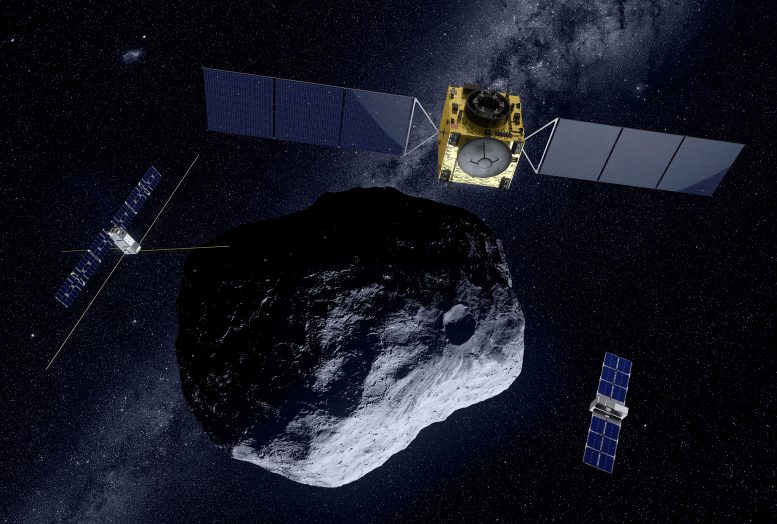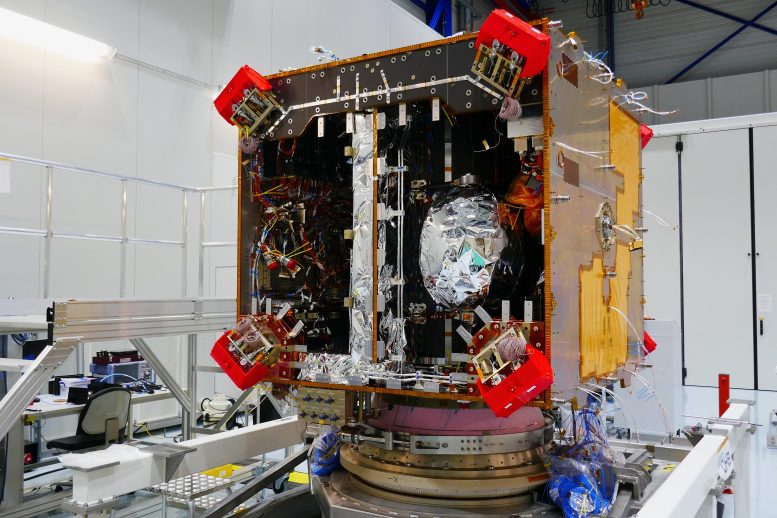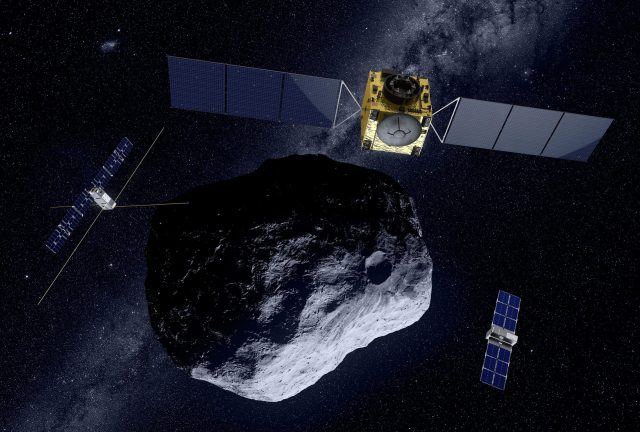
Należąca do ESA misja Hera pomyślnie wykonała kluczowe manewry, aby dopasować się do układu podwójnego planetoid Didymos, wykorzystując[{” attribute=”” tabindex=”0″ role=”link”>Mars for a gravity assist to shorten travel time.
As it journeys, Hera will study the effects of NASA’s DART mission on the asteroid Dimorphos, aiming to uncover mysteries surrounding binary asteroid systems and their formations.
Critical Maneuver Begins ESA’s Hera Mission
The European Space Agency’s Hera mission has successfully executed its first critical maneuver on its journey to the Didymos binary asteroid system, following its launch on October 7.
On October 23, Hera activated its three orbital control thrusters for 100 minutes, initiating its first deep-space maneuver and changing its velocity by about 146 m/s. A second, smaller burn on November 6, lasting 13 minutes, provided an additional boost of approximately 20 m/s.

These two carefully coordinated burns have set Hera on a precise trajectory for a gravity assist at Mars, planned for March 2025.
“Deep-space maneuvers are often split into parts,” said Sylvain Lodiot, Hera Spacecraft Operations Manager. “The first, larger burn does most of the work. Then, after precisely measuring the spacecraft’s trajectory, we use the second, smaller burn to correct any inaccuracy and provide the rest of the required boost.”
This successful maneuver builds on three earlier test burns conducted in the weeks following Hera’s launch by its control team at ESA’s European Space Operations Centre (ESOC) in Germany.

The team used the Agency’s deep space radio dishes in Spain, Argentina, and Australia to track Hera during the maneuver and to precisely measure its velocity before and after each burn.
“We are now analyzing Hera’s new trajectory following the second burn,” says Francesco Castellini from ESOC’s Flight Dynamics team, the mathematical experts that keep ESA missions across the Solar System on track.
“It appears to have gone very well. We will execute a much smaller correction maneuver of a few tens of cm/s on November 21 to fine-tune the trajectory for the upcoming Mars flyby.”

A Helping Hand From Mars
Hera is on a two-year journey to the Didymos binary asteroid system, where it will analyze the results of humankind’s first asteroid deflection experiment.
The recent deep-space maneuver was carefully calculated to line Hera up for a gravity assist in March 2025 that will shorten the travel time to Didymos.
“We are very fortunate that Mars is in the right place at the right time to lend a hand to Hera,” says Pablo Muñoz from ESOC’s Mission Analysis team, who planned Hera’s journey.
“This enabled us to design a trajectory that uses the gravity of Mars to accelerate Hera towards Didymos, offering substantial fuel savings to the mission and allowing Hera to arrive at the asteroids months earlier than would otherwise be possible.”

Scientific Opportunities and Future Maneuvers
Hera will also use the Mars flyby for some opportunistic science. The ESA teams have designed a trajectory that will see the spacecraft fly past Deimos at a distance of just 300 km before passing Mars itself, offering a rare chance to study this small and mysterious Martian moon.
Hera will then carry out a second deep space maneuver in February 2026 before a sequence of rendezvous maneuvers from October to December 2026 brings it into proximity of the asteroids.
At Didymos, Hera will begin its mission to answer questions such as: How and why do binary asteroid systems form? When NASA’s DART mission impacted Didymos’s moonlet Dimorphos in 2022, did it leave a crater, or did it reshape the entire asteroid? What is Dimorphos’s internal structure?
Coraz większy nacisk ESA na misje na asteroidy
To pracowity czas dla zespołów asteroid ESA. W październiku wystartowała pierwsza misja Agencji do asteroid Hera oraz rozpoczęły się prace nad drugą misją asteroidową, proponowaną Misja Ramzesa do asteroidy Apophis.
W międzyczasie Centrum Koordynacji Obiektów Blisko Ziemi ESA w dalszym ciągu odkrywa, śledzi i analizuje nowe asteroidy z Ziemi, a ostatnio pomogło zidentyfikować dziesiątą asteroidę w historii odkryte przed uderzeniem w Ziemię.
O Herze
Misja Hera Europejskiej Agencji Kosmicznej jest częścią międzynarodowej współpracy mającej na celu badanie dynamiki asteroid i obrony planetarnej. Celując w układ podwójny planetoid Didymos, Hera dokładnie zbada Dimorphos, miejsce uderzenia DART NASA w 2022 r., aby ocenić powstawanie kraterów, skład asteroidy i strukturę wewnętrzną. Łącząc dane o wysokiej rozdzielczości z najnowocześniejszymi osiągnięciami naukowymi, Hera ma na celu pogłębienie wiedzy na temat planetoid podwójnych i opracowanie skutecznych technik odchylania asteroid.




